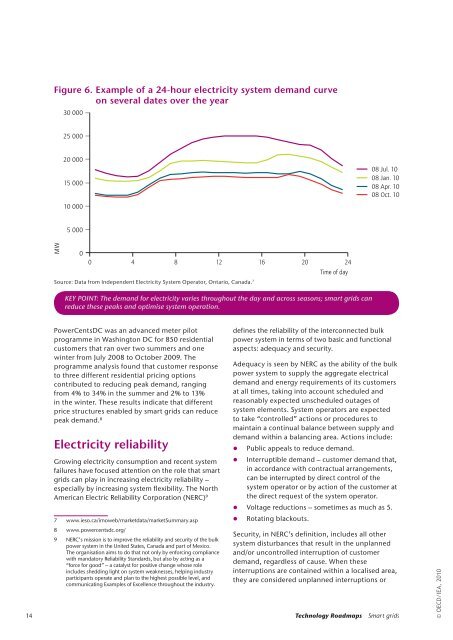Smart Grids Roadmap - Smart Grid Sherpa
Smart Grids Roadmap - Smart Grid Sherpa
Smart Grids Roadmap - Smart Grid Sherpa
- No tags were found...
You also want an ePaper? Increase the reach of your titles
YUMPU automatically turns print PDFs into web optimized ePapers that Google loves.
Figure 6. Example of a 24-hour electricity system demand curveon several dates over the year30 00025 00020 00015 00010 00008 Jul. 1008 Jan. 1008 Apr. 1008 Oct. 105 000MW00 4 8 12 16 20 24Time of daySource: Data from Independent Electricity System Operator, Ontario, Canada. 7KEY POINT: The demand for electricity varies throughout the day and across seasons; smart grids canreduce these peaks and optimise system operation.PowerCentsDC was an advanced meter pilot 7programme in Washington DC for 850 residentialcustomers that ran over two summers and onewinter from July 2008 to October 2009. Theprogramme analysis found that customer responseto three different residential pricing optionscontributed to reducing peak demand, rangingfrom 4% to 34% in the summer and 2% to 13%in the winter. These results indicate that differentprice structures enabled by smart grids can reducepeak demand. 8Electricity reliabilityGrowing electricity consumption and recent systemfailures have focused attention on the role that smartgrids can play in increasing electricity reliability –especially by increasing system flexibility. The NorthAmerican Electric Reliability Corporation (NERC) 97 www.ieso.ca/imoweb/marketdata/marketSummary.asp8 www.powercentsdc.org/9 NERC’s mission is to improve the reliability and security of the bulkpower system in the United States, Canada and part of Mexico.The organisation aims to do that not only by enforcing compliancewith mandatory Reliability Standards, but also by acting as a“force for good” – a catalyst for positive change whose roleincludes shedding light on system weaknesses, helping industryparticipants operate and plan to the highest possible level, andcommunicating Examples of Excellence throughout the industry.defines the reliability of the interconnected bulkpower system in terms of two basic and functionalaspects: adequacy and security.Adequacy is seen by NERC as the ability of the bulkpower system to supply the aggregate electricaldemand and energy requirements of its customersat all times, taking into account scheduled andreasonably expected unscheduled outages ofsystem elements. System operators are expectedto take “controlled” actions or procedures tomaintain a continual balance between supply anddemand within a balancing area. Actions include:14 Technology <strong>Roadmap</strong>s <strong>Smart</strong> gridszzzzPublic appeals to reduce demand.Interruptible demand – customer demand that,in accordance with contractual arrangements,can be interrupted by direct control of thesystem operator or by action of the customer atthe direct request of the system operator.zzVoltage reductions – sometimes as much as 5.zzRotating blackouts.Security, in NERC’s definition, includes all othersystem disturbances that result in the unplannedand/or uncontrolled interruption of customerdemand, regardless of cause. When theseinterruptions are contained within a localised area,they are considered unplanned interruptions or© OECD/IEA, 2010
















